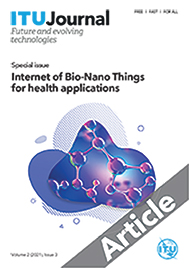|
Transmission and detection techniques for Internet of Bio-Nano Things applications with static and mobile molecular communication: A survey
|
Authors: Amit K. Shrivastava, Debanjan Das, Neeraj Varshney, Rajarshi Mahapatra
Status: Final
Date of publication: 12 July 2021
Published in: ITU Journal on Future and Evolving Technologies, Volume 2 (2021), Issue 3 - Internet of Bio-Nano Things for health applications, Pages 33-78
Article DOI : https://doi.org/10.52953/GXEZ7259
|
 | Abstract:
Recent studies have shown that designing communication systems at nanoscale and microscale for the Internet of Bio-Nano Things (IoBNT) applications is possible using Molecular Communication (MC), where two or multiple nodes communicate with each other by transmitting chemical molecules. The basic steps involved in MC are the transmission of molecules, propagation of molecules in the medium, and reception of the molecules at the receiver. Various transmission schemes, channel models, and detection techniques have been proposed for MC in recent years. This paper, therefore, presents an exhaustive review of the existing literature on detection techniques along with their transmission schemes under various MC setups. More specifically, for each setup, this survey includes the transmission and detection techniques under four different environments to support various IoBNT applications: (i) static transmitter and receiver in a pure-diffusive channel, (ii) static transmitter and receiver in a flow-induced diffusive channel, (iii) mobile transmitter and receiver in a pure-diffusive channel, (iv) mobile transmitter and receiver in a flow-induced diffusive channel. Also, performances and complexities of various detection schemes have been compared. Further, several challenges in detection and their possible solutions have been discussed under both static and mobile scenarios. Furthermore, some experimental works in MC are presented to show realistic transmission and detection procedures available in practice. Finally, future research directions and challenges in the practical design of the transmitter and receiver are described to realize MC for IoBNT health applications. |
|
Keywords: Detector design, Internet of Bio-Nano Things, modulation schemes, molecular communication, micro-scale and nanoscale communication
Rights: © International Telecommunication Union, available under the CC BY-NC-ND 3.0 IGO license.
|
|
| Detalle del artículo | Artículo | Precio | |
|---|
| 0
| Gratuito | Descargar |
|
|
| |